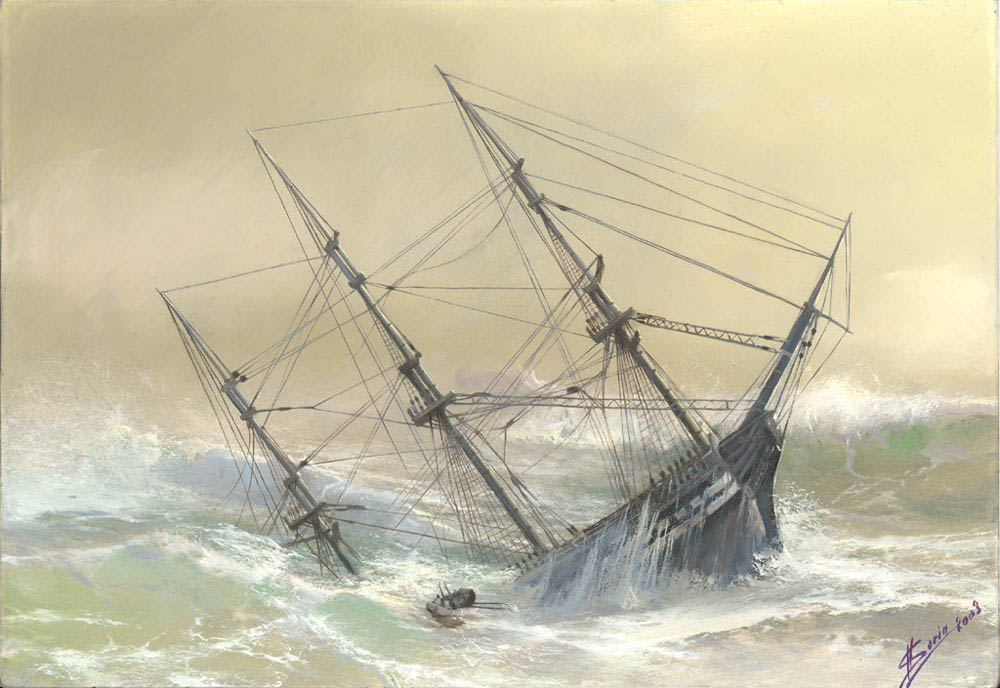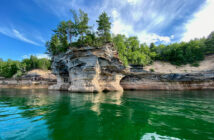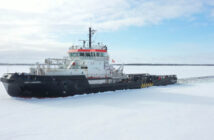A “missing” story intrigues us and solving it is the best part of a mystery. This is highly relevant for families to find their loved ones for closure in maritime disasters. With the collaboration of shipwreck hunter, Ross Richardson, over the course of time, The Scuba News Canada will publish some Great Lakes water mysteries. This is our first instalment, C.H. Hurd, and as Ross told us, has been searched for by him, but has not yet been discovered.
One of the most heart-wrenching shipwreck disasters to occur on Lake Michigan is the loss of the schooner C.H. HURD, which foundered near South Manitou Island in 1871. The following article was published in the Detroit Tribune on September 28th of that year, and tells the heartbreaking story through the eyes of the HURD’s captain, W.O. Harrison.
LOSS OF THE ” C.H. HURD.”
Full Particulars Concerning The Disaster
Captain Harrison, The Only Survivor. — His Statement
Captain Harrison, of the ill-fated schooner C.H. HURD, which was wrecked, as already published, on Friday night last, on Lake Michigan, arrived here yesterday on the CITY OF MONTREAL, and brought with him the remains of his wife A Tribune reporter called upon him, to whom he gave the following account of the loss of the vessel and the drowning of her crew and his family.
The three-masted schooner C.H. HURD left Chicago about 6 0’clock Thursday night, with a cargo of corn for Buffalo. The wind was fair and all canvas was set. The vessel continued on her course all night, the wind still being favorable, and blowing about the same until about noon on Friday. The wind the shifted somewhat until it was about southwest, and from that time until evening it continued to increase in velocity till at 4 o’clock it was blowing a living gale. I had been on deck all day watching the progress of the vessel, and sometimes taking the wheel, in order to take the most advantage possible of the fair wind. Sail had been shorted at various times during the day as the velocity of the wind increased, and at 4 o’clock, when the dog watch was called and the vessel was under nothing but her mainsail, foresail, jib and flying jib that being, for a three-masted vessel, very short sail. At this time the seas were running mountain high, and although the vessel staggered under even the small amount of canvas she carried, it was absolutely necessary to drive her fast enough to keep away from the seas which were running directly astern.
At o’clock, having just come up from supper, the vessel was about three miles S.S.W. from the southwest end of South Manitou Island. A sea of more than usual height came towering over the stern, rushing with irresistible force over the taffrail, and immediately took complete possession of the vessel fore and aft, sweeping everything not lashed down overboard. The schooner was deep loaded, having on board 27,700 bushels of corn, and was already down nearly to the plank-shear in the water, so that when this sea came aboard its weight sunk her down until the scuppers and lower part of the bulwarks were completely under water. The pressure of the water outside the bulwarks being greater than that inside, prevented the water from escaping, and the schooner was thus held down while sea after sea swept over her. One of them lifted the whole top part of the after cabin and dashed it overboard. The water then rushed into the cabin, and from there found its way into the hold. The forecastle scuttle was washed away, and some of the water got into the hold by that means. This was the only way in which the water could effect an entrance, as all three hatches were double battened down, with double tarpaulins, and were perfectly tight.
An extra squall striking the schooner at this time, she was thrown on her beam ends, which caused her to labor heavily. I was then standing at the wheel with one of the sailors, and had given orders to settle away the mainsail in order to ease the vessel, when another heavy sea washed over her, carrying with it, myself and the man at the wheel. I saved myself by catching hold of the reef tackle-fall of the main-boom, which was hanging over the side, and succeeded in drawing myself on deck. The other man went down. I had previously given instructions to the mate, my brother, to take my wife and child into the mizzen rigging, saying that I would take care of the schooner. He did so, and when I got aboard, I saw him with my wife and child in the mizzen-top. The men had also taken to the rigging, and seeing that the vessel was rapidly filling and going down, and that nothing could be done to save her, I threw off my coat, hat and boots, and prepared for the worst that could come. I then clambered into the main rigging, but had not got more than half-way up, when the vessel gave a sudden lurch and went down almost immediately, taking with her all the crew that were left, and my brother, wife, and child.
The suction of the sinking vessel dragged me down a considerable distance, but after being under water what seemed to me a very long time, and when my breath was almost gone, I at length reached the surface. A portion of the cabin roof that had been swept off was close beside me, and on this I clambered, and held myself by means of an iron ring that had been used for hanging a lamp in the cabin. In this way I continued for eleven hours, and only by the most determined efforts kept from perishing from cold and exhaustion. There was on the cabin roof an overcoat, and I held this in one hand, waiting for an opportunity to put it on, while with the other I clung to the iron ring. The sea continued to run high and to wash over me, but by turning face towards it, shutting my eyes, and holding my breath until a sea passed over, I was still enabled to keep my hold.
After midnight the wind lulled somewhat, and enabled me to throw the overcoat over my shoulders, although I was so numb as scarcely to be able to move. I found that I was rapidly becoming stiff, and that it was impossible for me to open my mouth. Thinking that something must be done to keep up the circulation. I had to resort to kicking with my feet, and striking the timbers with a piece of pine board that I discovered, held close between my knees.
About daylight, being then entirely exhausted, I came in sight of land, which proved to be the South-West end of the North Manitou Island, and shortly after the raft was landed by a great wave high and dry on the beach. I crawled out of the reach of the water and laid down on the beach, thinking that I had only come to a dry place to die. After lying down for some time I roused myself, thinking that life depended upon exertion and finding some habitation. Then, crawling to some land a little higher than the surrounding country, I looked around in all directions, and finally saw a wood-dock and some fishing huts about 2 1/2 miles from where I stood. My feet were now, from cold and from kicking the roof of the cabin, very much swollen and extremely sore and tender. Getting two sticks on the beach for canes, however, I managed to make my way over a stony beach and with bare feet, about two miles, sometimes falling down and crawling, and again getting up and walking with the aid of the canes. When about half a mile from the dock, I made some signals to the fishermen and dropped down, unable to proceed any further. The fishermen came to my relief and took me to their huts where I was kindly treated, and had every possible means of restoration applied I remained there three days, when I was brought to this city by the propeller CITY OF MONTREAL.
Only six short years would pass before Captain Harrison would join his wife, daughter, brother and crew of the C.H. HURD in Davy Jones Locker. In November 1877, Captain Harrison was swept off the steamer C.J. KERSHAW by a violent gale and disappeared beneath the waters of Saginaw Bay.
About Ross Richardson
Richardson is the author of two books, “The Search for the Westmoreland: Lake Michigan’s Treasure Shipwreck“ and “Still Missing: Rethinking the D.B. Cooper Case and Other Mysterious Unsolved Disappearances.” He also speaks about Great Lakes maritime history at libraries and historical societies around the Great Lakes Region.
Richardson is a trained technical SCUBA diver and has been involved in the discovery, identification, and documentation of numerous Lake Michigan shipwrecks. He was a public safety diver for the Benzie Area Public Safety Dive Team and a Benzie Country Sheriff’s Department Special Deputy for many years.
He resides in Lake Ann, Michigan, with his wife, son and their retired racing greyhound, Claire.









